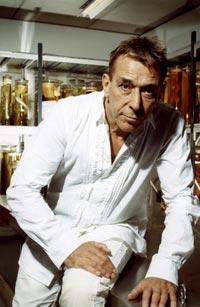

Interviews
The Poetics Project
Barbican Centre, London, UK
Text by Ken Clark
The Poetics Project is a multimedia art show currently on exhibit (until july 20, 2003) at the Barbican Centre. Of interest to John Cale fans is a 90-minute interview that forms part of one of the installations.
I shall not bother to conduct a review of the exhibition, leaving that to more capable talents. Instead I shall provide a brief synopsis of the interview.
There are several televisions in the centre of the exhibit each with two or three interviews on a continuous loop. David Byrne, Alvin Vega, Kim Deal are some of the musicians featured on the other monitors. Cale shares a tape sandwiched between Tony Conrad and Laurie Anderson.
The interview was likely done in 1999, as that is date of the piece. It is a single head shot which pans out and back in occasionally. The interviewer is not identified either on the tape or in the programme. The interviewer is possibly one of the artists in the exhibition and has some knowledge of Cale's work but is no expert.
The first part of the interview that lasts about 30 minutes consists entirely of the early work at Tanglewood and with Lamonte Young. John mentions the logistic problems with early collaborations. Does he compose a musical piece while a painter paints? Is it an interpretation of the emotions in the painting? The famous axe incident is described with great relish. One of Cale's early compositions involved a piece for prepared piano with two people one playing the keyboard, the other hidden in the piano. At one point the hidden player would leap out with an axe and smash the piano stool. "You could feel the oxygen leaving the room".
Cale discussed working with Lamonte Young and Xenakis on the theory of the drone and looking for sounds between the notes that would prove so useful to the next collaboration with Lou Reed. He discusses at length how unfortunate that the Lamonte Young material has not been released due to copyright conflicts. He stated that Lamonte Young claimed authorship of the material when Cale and Conrad had contributed a great deal to the composition. Fortunately it has been released subsequent to this interview.
The next main topic was about the work with the Velvet Underground and the multi-media performances that Andy Warhol had arranged at art galleries and psychiatrist conventions. Again Cale is given the time to stretch out and go into detail that has not emerged in other shorter interviews. He states the best collaborative work is where you ignore the other artist that is why the joint efforts with Warhol and the Velvets were so successful.
There is also some discussion about the production work with Iggy Pop and Nico. Then the interviewer jumps to the "Sabotage Live" era that is describe as "a study in paranoia". Cale nods in agreement. The next Lou collaboration "Songs For Drella" is also explored. Cale said it was only performed four times live "such is the longevity of a collaboration". Annoyingly the interviewer seems to jump around a great deal chronologically and also stops to think of a subsequent question. Cale is very gracious and waits for the next topic and all answers are expansive, often leading to tangents such as how wire publicity photos can be encrypted to indicate copyright. There is also a long discussion as to the limitations of the Mini Disc system. Cale reveals how the fidelity limitations were based on a questionnaire that was circulated in California. "When the cymbal crashes do you like to hear the bass / the guitar / the vocals?"
Annoyingly the interview starts to repeat segments near the end. I waited to see if there was any new material subsequent but when I head the same sequence a third time I gave up. I am not sure if this is a video error or intentional as a part of the exhibit, such are the complexities of modern art.
On the whole it was a very worthwhile interview and well worth the attention of any serious John Cale fan.
With all the recent media appearances it would appear that he is justifiably claiming his place in modern music. To any of his fans this is long overdue and I am sure he will receive the attention he deserves for his great and diverse body of work.